Samsung Galaxy Note 8.0 Review
by Anand Lal Shimpi on April 17, 2013 11:29 PM EST- Posted in
- Tablets
- Samsung
- Android
- Mobile
- Galaxy Note 8.0
GPU Performance
The GPU side of Samsung's Exynos 4 Quad is also powered by ARM, in this case we're talking about the Mali 400MP4. ARM's Mali 400 is also getting older, but when it arrived on the scene its performance was pretty respectable. To evaluate its performance, we turn to our recently expanded list of Android 3D benchmarks starting with 3DMark.
3DMark - Ice Storm
3DMark for Android features the Ice Storm benchmark and uses OpenGL ES 2.0. Ice Storm is divided into two graphics tests and a physics test. The first graphics test is geometry heavy while the second test is more pixel shader intensive. The physics test, as you might guess, is CPU bound and multithreaded. The overall score takes into account both graphics and physics tests. The benchmark is rendered to an offscreen buffer at 720p/1080p and then scaled up to the native resolution of the device being tested. This is a very similar approach we've seen by game developers to avoid rendering at native resolution on some of the ultra high resolution tablets. The beauty of 3DMark's approach here is the fact that all results are comparable, regardless of a device's native resolution. The downside is we don't get a good idea of how some of the ultra high resolution tablets would behave with these workloads running at their native (> 1080p) resolutions.
For these benchmarks we stuck with the default presets (720p, normal quality). I'm reporting the overall and physics scores here:
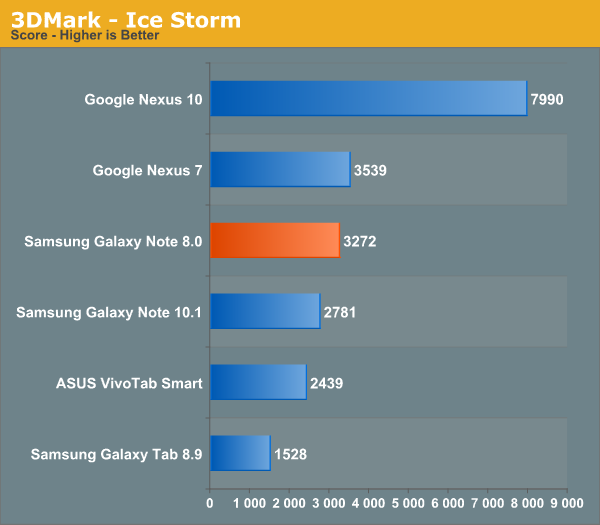
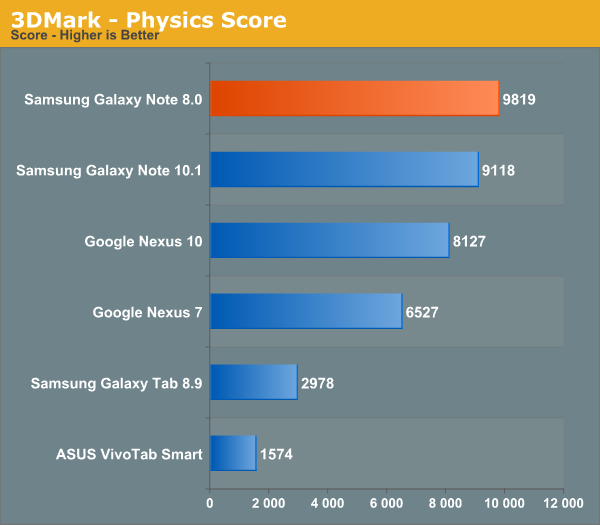
I tossed the physics test in here because it serves as an interesting multithreaded CPU benchmark. The results are largely unrealistic (a pair of Cortex A15s should almost always be quicker than four Cortex A9s at a lower frequency in most real world Android apps), but it does highlight the combination of core count and clock speed upgrades that we've seen over the past 2 years in the mobile tablet space.
Basemark X
Basemark X is a new addition to our mobile GPU benchmark suite. There are no low level tests here, just some game simulation tests run at both onscreen (device resolution) and offscreen (1080p, no vsync) settings. The scene complexity is far closer to GLBenchmark 2.7 than the new 3DMark Ice Storm benchmark, so frame rates are pretty low:
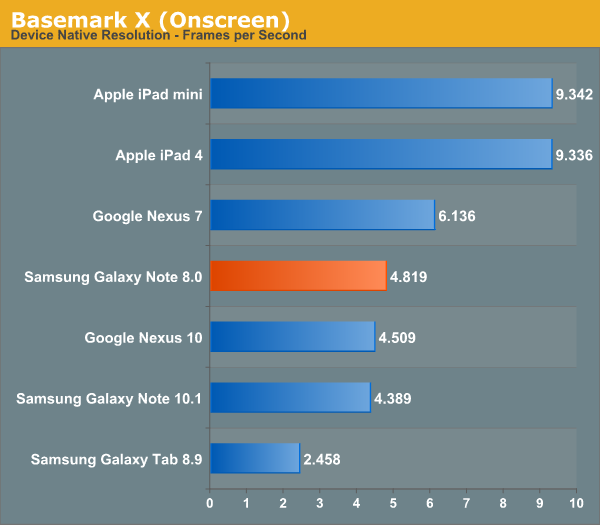
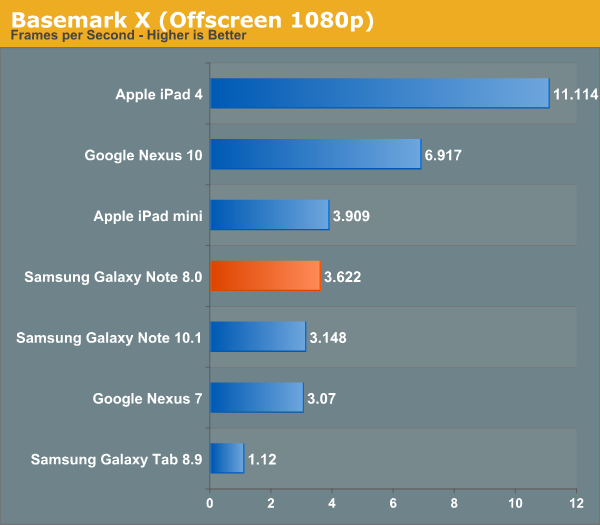
Basemark puts the Galaxy Note 8.0 behind the iPad mini in GPU performance and roughly 2 - 3x the performance of the Galaxy Tab 8.9.
GLBenchmark 2.7
GLBenchmark 2.7 gives us some low level results to look at. We'll start with peak theoretical fill rate and triangle throughput tests:

The Mali 400MP4 in the Galaxy Note 8.0 is capable of delivering similar fill rate to the PowerVR SGX 543MP2 in Apple's iPad mini, but the latter still holds an appreciable performance advantage. The gap between the 8.0 and 10.1 Galaxy Note models boils down to clock speeds. Compared to the old Galaxy Tab 8.9, the Note 8.0 puts its spiritual predecessor to shame.
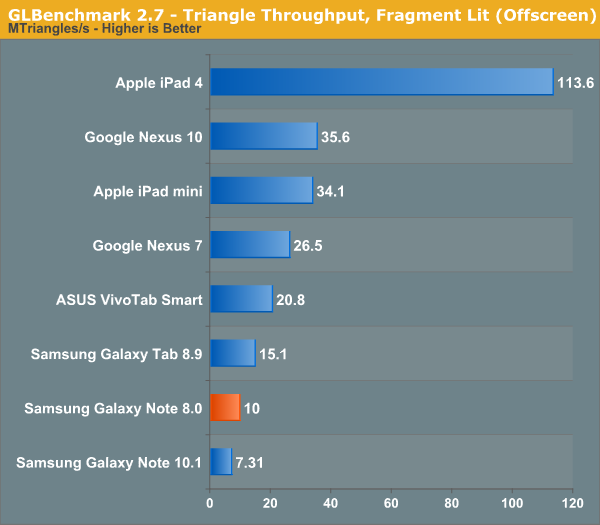
Can anyone say regression? ARM's Mali 400MP4 was never very strong from a triangle throughput standpoint, technically the Galaxy Tab 8.9 is quicker here (although you'll pretty much never see it surface in an actual game). The two GLBenchmark 2.7 test scenes follow:
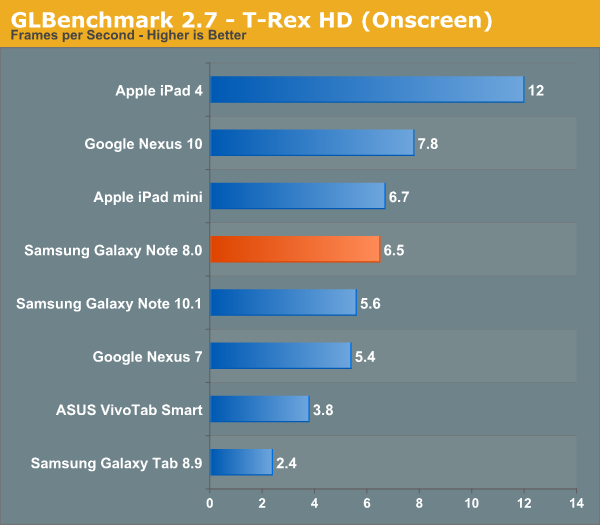

GLBench puts the Note 8's overall performance just slightly behind that of the iPad mini, and ahead of the mini if you compare identical workloads (offscreen 1080p). Obviously the GPU included here isn't anywhere near powerful enough to run the T-Rex HD workload at reasonable performance levels, but I wouldn't expect that to really hamper gaming performance for at least another two years.
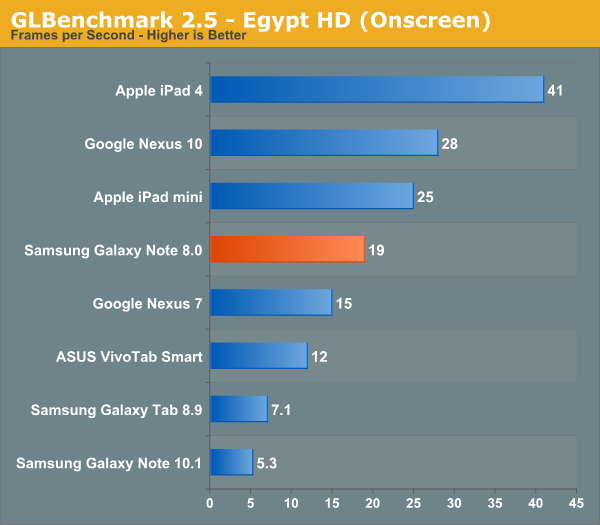
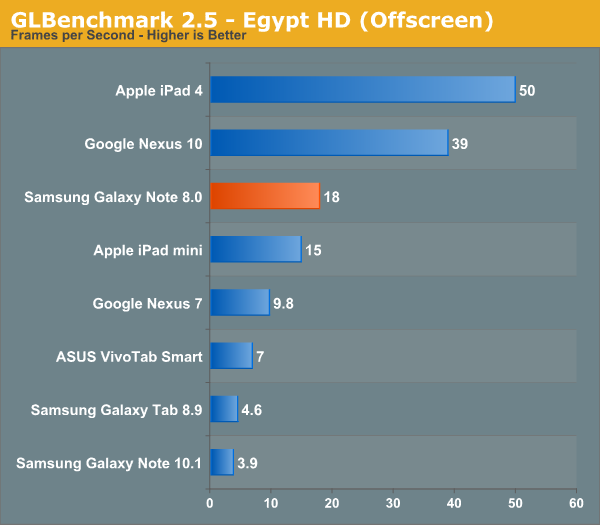
Egypt HD gives us a better look at what performance will look like in the near term. Once again, at native device resolution the iPad mini does better than the Note 8.0 but with the same workload/resolution their roles reverse. What we usually see, regardless of capabilities, is good real world performance by pretty much anything on the market. Most game developers seem to treat modern tablets like game consoles and attempt to deliver a good experience across the lowest common denominator rather than targeting the absolute high end.










95 Comments
View All Comments
HanakoIkezawa - Thursday, April 18, 2013 - link
Menu or back button. Hardware buttons and the "experience" are completely objective and chanfe from user to user. Ios devices drive me insane because I only have a menu button ans no back button, but my sister loves having only one button on her iphone. I feel lost on nexus devices because of the lack of hardware buttons but im sure some nexus owners how despise the note 8 layout.It's all matter of opinion.
antef - Thursday, April 18, 2013 - link
A menu button need not be in a permanent bar that uses screen real estate, it should be with the app's UI, which is what Google's guidelines indicate. It doesn't make sense for a large screen application to require a tiny button off-screen to be pressed to pull up app functionality. It's disjointed and unintuitive.Sabresiberian - Thursday, April 18, 2013 - link
Heh I suggest that the fact that the Surface Pro is based on any Ivy Bridge Core i5 chip could be the reason it is faster at, oh, everything. :)herts_joatmon - Thursday, April 18, 2013 - link
I mainly want this for sketching. I had no issues when trying it out in the samsung store. I was using Sketchbook pro though not s note. Had 4 layers on there (sketch, inking, backround colour and picture colour). It seemed to work fine through out. I only spent about 15 minutes playing though...GNUminex - Thursday, April 18, 2013 - link
As a college student I constantly see other students struggling to annotate lecture slides or or pdfs on their tablets, and/or struggling to type on their tablets. It really confounds me why no one has set out to make hardware that comprehensively meets the productivity needs of these people and then market the device to them. Keyboards that don't physically connect to the tablets and act as a base are not practical for all situations. The transformer's dock doesn't make a sturdy base. The Surfaces don't sit well on a lap and are too expensive. The Note finally solves the writing problem with it's stylus but has no keyboard, and the more traditional tablet laptops are too big and too expensive.The0ne - Thursday, April 18, 2013 - link
You've been using Win8 tablets for years? How can this be?The0ne - Thursday, April 18, 2013 - link
You've been using Win8 tablets for years? How can this be?nerd1 - Thursday, April 18, 2013 - link
Win8 developer preview was released July 2012 as far as I remember.ezekiel68 - Thursday, April 18, 2013 - link
I came in interested in the Note 8. I left interested in the Nexus 10.haukionkannel - Thursday, April 18, 2013 - link
Well, I came to the same conclusion than the article writer. I would take any day Nexys 7 with a s-pen over this product if it only would be available... Better screen, longer usage time, smaller size...Hopefully we will some day see "note" version of some of those small size Nexus tablets!
I don't mind a little bit weaker CPU or GPU as long as you get better screen and longer battery time!
But not a bad product at all!